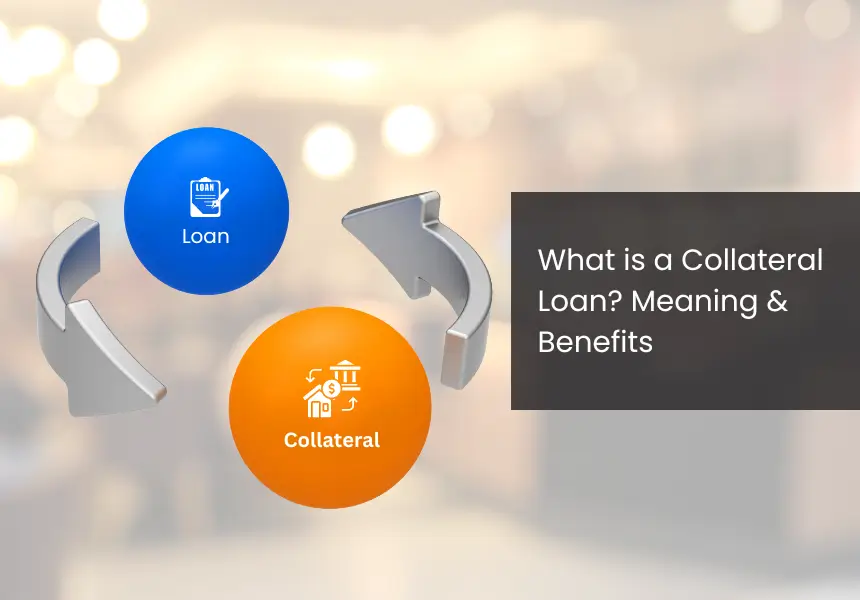
Need financing for a personal emergency or a big purchase? Collateral loans might be your answer!
But what are collateral loans? Let’s first understand the basics.
This article discusses what a collateral loan meaning, its benefits, and the different types available. By understanding how collateral loans work, you can decide if they’re the right way to finance your goals.
What is a Collateral Loan?
There are two main categories of loans: secured and unsecured loans. For unsecured loans (meaning no collateral required), you do not need to keep any of your valuable assets as a guarantee. Only your credit score will be affected if you cannot pay back on time.
On the other hand, we have secured loans, also known as collateral loans. Collateral loans mean that you are required to keep something valuable you own, like a car or jewelry, as a guarantee.
Think of it like this: When you buy a house, the house itself is the collateral for your mortgage. If you miss payments, the lender can foreclose, take ownership, and sell the house to recover their losses.
If you don’t repay the loan, the lender can use that collateral to recover the outstanding loan amount. This lowers their risk, so they can offer you a better deal on interest rates.
How Collateral Loans Work
Collateral loans are a type of secured loan where the borrower pledges an asset as collateral to the lender. This collateral acts as a security for the loan, reducing the risk for the lender and often allowing for better loan terms for the borrower. Here’s a brief overview of how collateral loans work:
Application and Evaluation:
The borrower applies for the loan and offers an asset (such as real estate, a vehicle, or savings) as collateral. The lender evaluates the value of the collateral and the borrower’s creditworthiness.
Loan Approval and Terms:
If the loan is approved, the lender determines the loan amount based on the value of the collateral and sets the interest rate, repayment schedule, and other terms.
Pledging Collateral:
The borrower pledges the collateral by transferring ownership or placing a lien on the asset. This means the lender has a legal claim to the asset until the loan is repaid in full.
Loan Disbursement:
The lender disburses the loan amount to the borrower, who can then use the funds for their intended purpose.
Repayment:
The borrower makes regular payments according to the agreed-upon schedule. These payments usually include both principal and interest.
Collateral Release:
Once the loan is fully repaid, the lender releases the lien or transfers the ownership of the collateral back to the borrower.
Default and Repossession:
If the borrower fails to repay the loan as agreed, the lender has the right to seize the collateral to recover the outstanding loan amount. This process varies based on the type of collateral and local laws.
Collateral loans are ideal for borrowers with lower credit scores or those needing larger loan amounts. The lower risk for the lender translates to potentially lower interest rates for you. However, remember that defaulting could mean losing your valuable possessions and negatively impacting your credit score.
Always carefully review the loan agreement before committing to a loan. Make sure you understand all the terms and conditions.
Benefits of Collateral Loans
Collateral loans, also known as secured loans, allow borrowers to access funds with potentially more favorable terms, making them an attractive option for those with valuable assets to use as security.
Here are some of the advantages that they offer:
Lower Interest Rates:
Because the loan is backed by an asset, lenders face less risk and often provide lower interest rates compared to unsecured loans.
Higher Borrowing Limits:
With collateral, borrowers can often access larger loan amounts since the lender has a way to recover their money if the borrower defaults.
Easier Approval:
Securing a loan with collateral can make it easier to get approved, especially for borrowers with lower credit scores or limited credit history.
Flexible Terms:
Lenders may offer more flexible repayment terms on collateral loans, providing borrowers with options that fit their financial situations.
Access to Different Types of Loans:
Collateral loans can come in various forms, such as home equity loans, auto loans, and mortgage loans, allowing borrowers to choose the best option for their needs.
Types of Collateral Loans
There are several types of collateral loans available. Here are some of them:
Mortgage Loans:
These loans are secured by real estate. The property is used as collateral, and if the borrower defaults, the lender can foreclose on the property to recover the loan amount.
Auto Loans:
These loans are secured by the vehicle being purchased. If the borrower fails to make payments, the lender can take possession of the vehicle.
Secured Personal Loans:
These can be backed by various assets, such as savings accounts, certificates of deposit (CDs), or investment accounts. The collateral must be valuable enough to cover the loan amount.
Home Equity Loans and Lines of Credit (HELOCs):
These are loans where the borrower’s home equity (the market value of the home minus any outstanding mortgage) is used as collateral.
Pawn shop Loans:
These are short-term loans where borrowers pledge personal items, such as jewelry or electronics, as collateral. If the loan is not repaid, the pawnshop sells the item.
Business Loans:
Some lenders offer secured business loans. Businesses can secure loans using company assets, such as equipment, inventory, or accounts receivable, as collateral.
How to Apply for a Collateral Loan?
Follow these steps to apply for a collateral loan:
Gather Documentation:
Collect necessary documents such as proof of income, financial records, paperwork related to the collateral, and any other required documentation. While lenders may request additional information, having these documents ready can speed the application process.
Submit an Application:
Shop around to find competitive interest rates and repayment terms that fit your budget. Choose your lender and submit an application with the required information, documentation, and details about your collateral asset. Visit the lender’s website for application instructions. In some cases, you may need to apply in person or speak to a representative.
Submit Collateral for Appraisal:
The lender will valuate your collateral to determine its value. This may involve a physical inspection of assets like property or vehicles.
Receive Loan Agreement:
After your loan moves through underwriting and verification, the lender will provide a loan agreement outlining the repayment terms. Review the documents carefully to understand your rights and responsibilities before accepting the loan.
Begin Repayment:
Once the lender disburses the loan amount, use the funds for the specified purpose in your loan agreement. Make all payments on time and in full to avoid defaulting on the loan and risking the loss of your collateral.
Conclusion
Collateral loans are a savior in times of emergency as they offer a reliable source of funds. They offer lower interest rates, larger loan amounts, and more favorable terms, making them an attractive option for many. Whether for emergencies or buying a home, collateral loans provide a flexible and efficient solution to access essential funds. As with any financial decision, you must understand the terms and conditions and choose a lender that best meets your needs.
Not comfortable putting up an asset? Unsecured loans might be a better fit. These don’t involve collateral; you only need a good credit score to get competitive interest rates. Loantap offers unsecured personal loans of up to Rs. 10 lakhs at competitive interest rates and repayment terms up to 60 months.
Frequently Asked Questions
What types of assets can be used as collateral?
Common assets include real estate, vehicles, savings accounts, stocks, bonds, and other valuable personal property.
How does the value of collateral affect the loan amount?
The loan amount is usually a percentage of the collateral’s value, with lenders typically offering 70-90% of the asset’s appraised value.
Can I use multiple assets as collateral for a single loan?
Some lenders may allow you to use multiple assets to secure a larger loan amount or improve your loan terms.
How is the collateral valuation?
The lender usually conducts a valuation process, which may involve a professional appraiser to determine the asset’s current market value.
What should I consider before applying for a collateral loan?
Consider the value of your collateral, the loan terms, interest rates, repayment ability, and the risk of losing your asset if you default on the loan.








